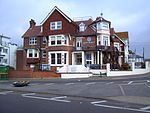Westcliff railway station
DfT Category F1 stationsFormer London, Tilbury and Southend Railway stationsPages with no open date in Infobox stationRailway stations in Great Britain opened in 1895Railway stations in Southend-on-Sea ... and 2 more
Railway stations served by c2cUse British English from June 2015

Westcliff railway station is on the London, Tilbury and Southend line, serving the locality of Westcliff-on-Sea in Southend-on-Sea, Essex. It is 34 miles 66 chains (56.0 km) down the main line from London Fenchurch Street via Basildon and it is situated between Chalkwell to the west and Southend Central to the east. Its three-letter station code is WCF. It was opened in 1895 by the London, Tilbury and Southend Railway. The station and all trains serving it are currently operated by c2c.
Excerpt from the Wikipedia article Westcliff railway station (License: CC BY-SA 3.0, Authors, Images).Westcliff railway station
Station Road, Southend-on-Sea Westcliff-on-Sea
Geographical coordinates (GPS) Address Nearby Places Show on map
Geographical coordinates (GPS)
| Latitude | Longitude |
|---|---|
| N 51.537 ° | E 0.691 ° |
Address
Station Road
Station Road
SS0 7SB Southend-on-Sea, Westcliff-on-Sea
England, United Kingdom
Open on Google Maps







